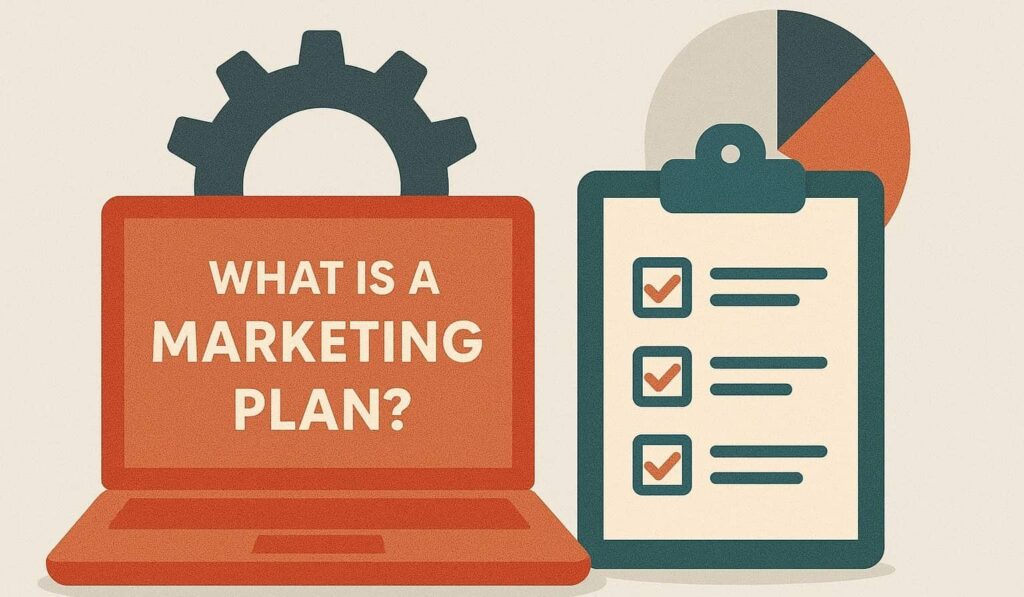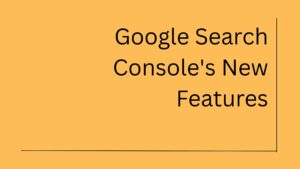Marketing can feel like a big, swirling mix of ideas, platforms, goals, and changing customer behaviors. And honestly, it often is. That’s why a marketing plan exists. It’s not just a document for the sake of having one, it’s what keeps your business from wandering aimlessly and throwing money at random strategies.
Whether you’re a startup trying to gain your first 100 customers or a small business looking to outdo last quarter, a marketing plan gives you structure, focus, and a way to measure what’s actually working. It’s not optional. It’s foundational.
Let’s unpack what an actual marketing plan is, without the corporate fluff or the textbook mumbo jumbo.
What Exactly Is a Marketing Plan?
A marketing plan is a written roadmap that serves as your business’s strategic guide through the complex landscape of customer acquisition and retention. It outlines how your business will reach its ideal customers, promote and market your products or services, and achieve specific goals over a set period, usually 3, 6, or 12 months, though some businesses create 18-month or even 24-month plans for longer-term strategic initiatives.
Think of it like this: If your business plan tells people what your company is about and why it exists in the marketplace, then your marketing plan shows how you’ll tell the world about it and convince them to care.
It usually includes your goals, target audience, budget allocation, marketing channels, detailed timeline, and comprehensive metrics for measuring results. But that’s just the surface level of what makes a marketing plan valuable. A good plan goes much deeper, connecting high-level strategy with daily actionable tasks, creating alignment between different departments, and establishing a framework for making consistent decisions when faced with new opportunities or challenges.
The most effective marketing plans also include contingency scenarios, competitive response strategies, and clear guidelines for when and how to pivot based on market feedback or changing business conditions.
Why Do You Need a Marketing Plan?
If you’ve ever run an ad campaign and had no idea whether it actually generated meaningful results or sent a hundred carefully crafted emails without receiving a single reply or engagement, you already know the answer to why planning matters.
A comprehensive marketing plan serves multiple critical functions that go far beyond basic organization:
- Keeps everyone aligned and moving in the same direction. Your entire team knows the specific goals, the chosen channels, the key messages, and the priorities for resource allocation. This prevents the common scenario where marketing, sales, and customer service teams are essentially working for different companies.
- Prevents costly guesswork and reactive decision-making. You’re not making important marketing decisions based on gut feelings, competitor panic, or whatever trend happened to catch your attention that week.
- Helps manage budgets more effectively and strategically. No more burning through cash on “maybe this will work” experiments or spreading resources so thin across multiple channels that nothing gets the attention it needs to succeed.
- Tracks what’s actually working versus what just feels busy. So you can intelligently double down on successful tactics or pivot early before wasting significant time and money.
- Builds measurable accountability across the entire organization. It’s much harder to hide behind vague statements like “we tried our best” when you have clearly defined KPIs, deadlines, and success metrics that everyone agreed to upfront.
Without a structured plan, it’s incredibly easy to chase every new marketing trend, spread yourself impossibly thin across too many channels, or completely forget who you’re actually marketing to when you get caught up in the excitement of a new campaign idea. The result is usually scattered efforts that generate lots of activity but very little meaningful business impact.
Key Elements of a Marketing Plan
Let’s break down the core components you’ll typically find in a well-structured marketing plan. These aren’t just bureaucratic formalities or boxes to check, they’re there because they systematically answer the fundamental questions every business needs to address before spending time and money on marketing activities.
1. Executive Summary
This is a high-level overview that distills your entire strategy into a digestible format. It gives readers, whether they’re internal stakeholders, potential investors, or agency partners a quick but comprehensive snapshot of what the plan is about, including your primary goals, your strategic focus areas, and your main tactical approaches. If someone only reads this single page due to time constraints, they should still understand the gist of your marketing strategy and feel confident in your approach. The best executive summaries also include a brief rationale for why this particular strategy makes sense for your business at this specific point in time.
2. Market Research & Analysis
This section represents the foundation upon which your entire marketing strategy is built. It digs deep into multiple layers of analysis:
- Your industry landscape and emerging market trends that could impact customer behavior or create new opportunities
- Detailed customer demographics, psychographics, and behavioral patterns including how they make purchasing decisions and what influences those decisions
- Comprehensive competitor analysis that goes beyond just looking at direct competitors to include indirect competitors and alternative solutions your customers might consider
- SWOT analysis (Strengths, Weaknesses, Opportunities, Threats) that honestly assesses your competitive position and identifies both advantages to leverage and vulnerabilities to address
Why invest time in this research?
Because if you’re marketing without truly understanding your competitive environment, customer motivations, and market dynamics, essentially marketing blind, you’re already operating at a significant disadvantage and likely wasting resources on strategies that seemed logical but don’t align with market realities.
3. Target Audience
This goes far beyond basic demographic information like age ranges or gender distribution. Truly effective audience definition requires you to develop a deep, almost intimate understanding of your ideal customers:
- What do they genuinely care about in their personal and professional lives?
- What specific problems, frustrations, or pain points keep them awake at night or cause them daily stress?
- What platforms, websites, podcasts, or publications do they regularly use to consume information and make decisions?
- What language, tone, and messaging style do they naturally respond to, and what immediately turns them off?
- What objections or concerns do they typically have about solutions like yours, and what evidence do they need to feel confident in their decision?
The more detailed and specific your understanding becomes, the more you can communicate with them like you’re having a genuine conversation with a real person who has specific needs and concerns, rather than broadcasting generic corporate messages through a company megaphone that nobody really wants to hear.
4. Marketing Goals
Set crystal clear, measurable objectives that leave no room for ambiguous interpretation. Avoid vague aspirations like “increase brand awareness” or “improve customer engagement.” These are too open-ended and provide no concrete way to determine success or failure.
Instead, use the proven SMART methodology for goal setting:
- Specific: Exactly what will be accomplished?
- Measurable: How will progress and success be quantified?
- Achievable: Is this realistic given current resources and market conditions?
- Relevant: Does this directly support broader business objectives?
- Time-bound: When exactly will this be accomplished?
For example: “Generate 500 qualified leads through targeted LinkedIn advertising campaigns in Q4, with a maximum cost per lead of $50 and a lead-to-customer conversion rate of at least 15%.” This goal provides clear targets for campaign performance, budget efficiency, and downstream sales impact.
5. Marketing Strategies and Tactics
This represents the meat of your entire plan the section that transforms strategic thinking into concrete action. It systematically answers the most important implementation questions:
- What specific channels will you use to reach your audience? (Email marketing, SEO, paid advertising, content marketing, social media, industry events, partnerships, etc.)
- What’s your core message and value proposition that will differentiate you from competitors and resonate with your target audience?
- How will you stand out in an increasingly crowded marketplace where customers are bombarded with marketing messages every day?
- What content formats and campaign types will you create to engage your audience at different stages of their buying journey?
This section can vary dramatically depending on your business size, industry, available resources, and specific goals, but it absolutely needs to demonstrate how you’ll actually reach real people and motivate them to take meaningful action. The best strategy sections also explain why certain channels were chosen over others and how different tactics will work together synergistically.
6. Budget
How much will it realistically cost to execute all the strategies and tactics you’ve outlined? A comprehensive budget should include detailed breakdowns for:
- Direct advertising spend across all paid channels
- Essential tools and software subscriptions needed for execution and measurement
- Contractor, freelancer, or agency fees for specialized expertise or additional capacity
- Content production costs including design, video, photography, and copywriting
- Events, sponsorships, or partnership investments that support your overall strategy
- Contingency funds for unexpected opportunities or necessary adjustments
Remember that your budget isn’t just about financial limits, it’s also a clear statement about priorities and where you believe you’ll get the best return on investment. A well-structured budget also makes it easier to track spending throughout the campaign and adjust allocations based on performance.
7. Timeline and Campaign Calendar
When will each initiative launch, run, and conclude? Create a detailed calendar that maps out your marketing initiatives month-by-month (or week-by-week for shorter-term plans or time-sensitive campaigns). This comprehensive timeline helps ensure consistent execution and prevents important activities from being overlooked or delayed.
A good timeline also shows how different campaigns and tactics relate to each other, identifies potential resource conflicts, and helps coordinate marketing activities with other business operations like product launches, sales cycles, or seasonal trends. This level of planning keeps your entire team accountable and makes it much easier to identify when something is falling behind schedule.
8. Metrics and KPIs
What specific metrics will you measure, and how will you collect and analyze that data? Different goals require different measurement approaches:
Some essential examples include:
- Website traffic volume and quality including organic search rankings and referral sources
- Email marketing performance including open rates, click-through rates, and conversion rates
- Cost per lead and customer acquisition cost across different channels and campaigns
- Conversion rates at each stage of your sales funnel
- Return on investment (ROI) from specific campaigns and overall marketing spend
- Brand awareness and engagement metrics including social media reach and mention sentiment
The fundamental principle is simple: if you can’t measure it accurately, you can’t improve it systematically. Your measurement plan should also include regular reporting schedules and clearly defined processes for how data will inform future decisions.
Different Types of Marketing Plans
Not all marketing plans are structured the same way or serve identical purposes. Some are comprehensive and broad in scope, while others focus intensively on just one specific strategy, channel, or business objective. Understanding these different approaches helps you choose the right framework for your current situation:
- Annual Marketing Plan: Covers the full calendar year with comprehensive goals, detailed budget allocations, and integrated multi-channel strategy. These plans work best for established businesses with predictable revenue cycles and sufficient resources to execute sustained campaigns.
- Content Marketing Plan: Specifically focused on content creation, editorial calendars, distribution strategies, and content performance measurement. These plans are particularly valuable for businesses using content to build thought leadership, improve SEO, or nurture long sales cycles.
- Social Media Plan: Lays out platform-specific strategies, detailed posting schedules, community engagement tactics, and social advertising approaches. These plans often include brand voice guidelines and crisis management protocols.
- Product Launch Plan: Built specifically around introducing a new product or service to the market, including pre-launch awareness campaigns, launch day coordination, and post-launch follow-up strategies.
- Digital Marketing Plan: Focuses exclusively on online channels, including SEO, PPC advertising, email marketing, and digital lead generation. These plans are ideal for businesses that operate primarily in digital spaces or want to shift their marketing focus online.
The key is to pick the type that matches your current primary objective and available resources. Don’t try to cram everything into one massive plan; if it doesn’t serve your focus, you’ll end up with a document that’s too complex to execute effectively.
How to Actually Create One (Without Losing Your Mind)
Here’s a practical, step-by-step approach that makes the planning process feel manageable and productive even if you’re not a professional marketer by trade or training:
Step 1: Start With the “Why”
What’s the fundamental business purpose behind this marketing plan? Are you primarily focused on growth and customer acquisition? Customer retention and lifetime value? Brand positioning and market differentiation? Having clarity on this foundational question will guide every other decision in your plan.
Step 2: Define the End Goal
Figure out what success looks like in concrete, measurable terms. More qualified leads generated? Better engagement rates across your content? Higher customer lifetime value? Increased market share in a specific segment? The more specific and measurable your definition of success, the easier it becomes to create strategies that actually achieve it.
Step 3: Study Your Audience Deeply
Invest serious time in understanding not just who your customers are demographically, but what they genuinely feel, think about, and act on. Conduct customer interviews, analyze your best existing customers, study their online behavior, and identify the emotional drivers behind their purchasing decisions.
Step 4: Choose Your Channels Wisely
You absolutely don’t have to be present on every available platform or use every possible marketing channel. Instead, strategically pick the few channels where your specific audience actually spends time and engages with content and where you have the resources and expertise to show up consistently with high-quality efforts.
Step 5: Write It Out, But Keep It Practical
Remember that this isn’t an academic thesis or a document designed to impress people with your strategic thinking. Your marketing plan should be genuinely useful for day-to-day decision making, not just impressive to read. Focus on clarity and actionability over complexity and jargon.
Step 6: Build In Regular Checkpoints
Don’t wait until the end of the quarter or campaign to evaluate performance and make necessary adjustments. Set up monthly or bi-weekly reviews to track progress against your goals, identify emerging trends, and make tactical tweaks before small problems become major issues.
What Happens If You Don’t Have A Marketing Plan?
Some businesses, especially in the early startup stages, deliberately skip creating a formal marketing plan. They prefer to “wing it” or improvise their marketing approach as opportunities arise. And yes, sometimes this scrappy, opportunistic approach works reasonably well… but usually only for a limited time and under specific circumstances.
But eventually, one of these predictable problems hits:
- You start spending significantly more money but getting proportionally less results because there’s no strategic framework for evaluating which activities actually drive business outcomes.
- Your team members become misaligned and work at cross-purposes because there’s no shared understanding of priorities, target audience, or success metrics.
- Your messaging becomes inconsistent across different channels and touchpoints which confuses customers and weakens your brand recognition and trust.
- You consistently miss valuable opportunities because there’s no systematic process for identifying, evaluating, and capitalizing on potential partnerships, trends, or market shifts.
Having a well-thought-out marketing plan doesn’t automatically guarantee success. Market conditions change, competitors respond, and unexpected challenges arise. But not having any plan almost certainly guarantees inefficiency, wasted resources, and missed opportunities that could have significantly impacted your business growth.
Real-World Example for Perfect Marketing Planning
Let’s say you run a boutique skincare brand targeting conscious consumers who value natural ingredients and sustainable practices.
Your comprehensive marketing plan for Q4 might look like this:
- Primary Goal: Increase holiday season sales revenue by 20% compared to the previous year, while maintaining current profit margins
- Target Audience: Health-conscious Gen Z and Millennials, primarily female, with disposable income for premium skincare, who actively follow beauty influencers and prioritize ingredient transparency
- Selected Channels: Instagram for visual storytelling, email for personalized communication, micro-influencer partnerships for authentic reviews, and strategic placement in holiday gift guides
- Specific Tactics:
- Launch a “12 Days of Skincare” holiday countdown campaign featuring daily tips, ingredient spotlights, and exclusive offers
- Collaborate with 5 carefully selected micro-influencers who align with brand values and have engaged audiences in the target demographic
- Create a sophisticated email series offering time-sensitive discounts to different customer segments based on purchase history
- Implement retargeting ad campaigns for website visitors who abandoned their shopping carts
- Total Budget: $10,000 strategically allocated across all platforms and activities
- Key Performance Indicators: Conversion rate improvement, total revenue growth, engagement rate increases, and cost per sale optimization
This skincare brand example demonstrates how a focused plan can coordinate multiple tactics toward a single, measurable objective. The 20% sales increase goal is specific and time-bound, making it easy to track progress and determine success. The audience definition goes beyond basic demographics to include behavioral insights (skincare-savvy, Instagram-heavy), which directly informs channel and messaging decisions.
The tactics chosen work synergistically rather than competing for attention. The “12 Days of Skincare” countdown creates daily engagement opportunities and builds anticipation, while the micro-influencer collaborations provide authentic product demonstrations and social proof. The email discounts capture people who are already interested but need an extra incentive to purchase, and the retargeting ads ensure that interested visitors don’t slip away due to simple forgetfulness or distraction.
The budget allocation might break down as follows: $4,000 for influencer partnerships, because businesses particularly the retail segment, give more focus on influencer marketing. And then content creation, $3,000 for paid advertising and retargeting campaigns, $2,000 for email marketing platform and design resources, and $1,000 for promotional materials and unexpected opportunities. This distribution reflects the importance of authentic content creation while maintaining a budget for amplification through paid channels.
Success measurement goes beyond just revenue to include leading indicators like engagement rates, email open rates, and cost per acquisition. These metrics help identify which tactics are working during the campaign, allowing for real-time optimization rather than waiting until the end to evaluate performance. The plan also implies a post-campaign analysis to capture learnings for future holiday seasons and identify which tactics deserve increased investment in the following year.
This example demonstrates focus, specificity, and measurable outcomes while maintaining realistic resource constraints.
No Plan is Perfect; It’s Not Set in Stone
One final but crucial point: your marketing plan should be treated as a living, breathing document that evolves with your business and market conditions.
You’re not only allowed to make adjustments you should actively plan to adjust based on real-world feedback and performance data. If a particular tactic isn’t delivering expected results after a reasonable testing period, drop it and reallocate those resources to something more promising. If something is significantly overperforming your expectations, scale it up and learn from what’s working so well.
A rigid, inflexible plan that never changes defeats the entire purpose of strategic planning. The goal is to provide clarity and direction for decision-making, not to create an inflexible set of rules that prevent you from responding to opportunities and market feedback. The best marketing plans build in mechanisms for regular evaluation, adjustment, and optimization based on actual performance data rather than just initial assumptions.
Conclusion
Creating a marketing plan isn’t about perfection; it’s about direction. Whether you’re a startup with limited resources or an established business looking to optimize, a well-crafted plan transforms scattered marketing efforts into strategic growth drivers. It keeps you focused on what matters, accountable to measurable results, and adaptable when markets shift. Start simple, stay consistent, and remember that the best plan is the one you actually execute. Stop guessing, start planning, and watch your marketing efforts finally deliver the results your business deserves.
Common Marketing Plan-related FAQs
There’s no magic number. A small business plan might be 3–5 pages, while a corporate plan could be 50+. What matters is clarity, not length. If someone can understand your strategy and execution just by reading it, it’s long enough.
At least once a quarter. But if you’re launching a new digital product, switching markets, or if performance is off track, revisit it sooner. The plan is a guide, not a contract. And so you need to know how to market a digital product you make, though.
Absolutely. You can create a plan just for launching a new service, running a holiday campaign, or entering a new region. Focused plans are often more effective because they cut through the noise.
It depends on your company’s size. But ideally: marketing leads, sales, customer support, product managers, and leadership. A good plan reflects cross-functional insights, not just one team’s view.
Not quite. The strategy is the “why” and “what.” The plan is the “how.” Think of the plan as putting strategy into action step-by-step, with timelines, budgets, and tactics.
Yes, even more than larger businesses. Startups are short on time, money, and team power. A clear plan helps you avoid waste, move faster, and make better decisions early on.

The Chief Editor cum author at Intothecommerce, bringing a unique blend of traditional and digital marketing expertise to the team. I oversee all editorial operations, utilizing my comprehensive knowledge to bridge classic marketing principles with modern digital strategies. My focus ensures our content is both timely and fundamentally sound.






1 thought on “What is a Marketing Plan? Elements, Types, and Examples”
Taking care of my marketing activities has never been easy without a proper plan, and I hope it is what the author is also trying to claim. Planning is a mandatory thing and must be on top of your priority list. It may still vary from person to person, approach to approach, or even business to business, but this is the base. So, well, at the end, it’s such a small gist of a list that may bring a big difference.